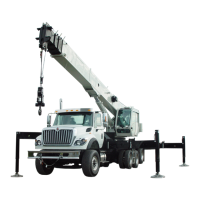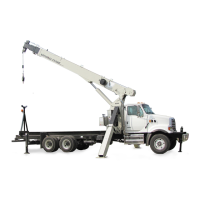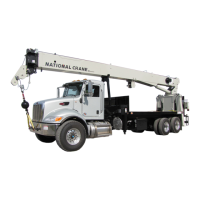National Crane 3-29-2018 Control # 610-00 3-9
NBT40-1 SERIES OPERATOR MANUAL SAFETY INFORMATION
United States OSHA regulations require a flagman when
operating in close proximity to energized power lines.
Appoint a reliable and qualified signal person, equipped with
a loud signal whistle or horn and voice communication
equipment, to warn the operator when any part of the aerial
lift near a power source. This person should have no other
duties while the aerial lift is working.
Do not store aerial lift under power lines or close to electrical
power sources.
Electrocution Hazard Devices
The use of insulated boom cages/guards, proximity warning
devices, or mechanical limit stops does not assure that
electrical contact will not occur. Even if codes or regulations
require the use of such devices, failure to follow the rules
listed here may result in serious injury or death. You should
be aware that such devices have limitations and you should
follow the rules and precautions outlined in this manual at all
times even if the aerial lift is equipped with these devices.
Boom cages and boom guards afford limited protection from
electrocution hazards. They are designed to cover only the
boom nose and a small portion of the boom. Performance of
boom cages and boom guards is limited by their physical
size, insulating characteristics, and operating environment
(e.g. dust, dirt, moisture, etc.). The insulating characteristics
of these devices can be compromised if not kept clean, free
of contamination, and undamaged.
Proximity sensing and warning devices are available in
different types. Some use boom nose (localized) sensors
and others use full boom length sensors. Reliance is placed
upon you, the operator, in selecting and properly setting the
sensitivity of these devices.
Never rely solely on a device to protect you and your fellow
workers from danger.
Some variables you must know and understand are:
• Proximity devices are advertised to detect the existence
of electricity and not its quantity or magnitude.
• Some proximity devices may detect only alternating
current (AC) and not direct current (DC).
• Some proximity devices detect radio frequency (RF)
energy and others do not.
• Most proximity devices simply provide a signal (audible,
visual, or both) for the operator; this signal must not be
ignored.
• Sometimes the sensing portion of the proximity devices
becomes confused by complex or differing arrays of
power lines and power sources.
Do not depend on grounding. Grounding of an aerial lift
affords little or no protection from electrical hazards. The
effectiveness of grounding is limited by the size of the
conductor (wire) used, the condition of the ground, the
magnitude of the voltage and current present, and numerous
other factors.
Electrical Contact
If the aerial lift should come in contact with an energized
power source, you must:
1. Stay in the aerial lift work platform. Don’t panic.
2. Immediately warn personnel in the vicinity to stay away.
3. Attempt to move the aerial lift away from the contacted
power source using the aerial lift’s controls which are
likely to remain functional.
4. Stay in the aerial lift until the power company has been
contacted and the power source has been de-energized.
No one must attempt to come close to the aerial lift until
the power has been turned off.
Only as a last resort should an operator attempt to leave the
aerial lift upon contacting a power source. If it is absolutely
necessary to leave the operator’s station, jump completely
clear of the aerial lift when the distance to the ground is
considered safely within reason. Do not step off. Hop away
with both feet together. Do not walk or run.
Following any contact with an energized electrical source,
the National Crane distributor must be immediately advised
of the incident and consulted on necessary inspections and
repairs. Thoroughly inspect all points of contact on the aerial
lift. Should the distributor not be immediately available,
contact Manitowoc Crane Care. The aerial lift must not be
returned to service until it is thoroughly inspected for any
evidence of damage and all damaged parts are repaired or
replaced as authorized by your National Crane distributor or
Manitowoc Crane Care.

